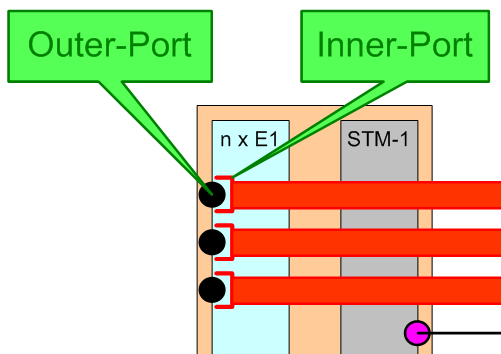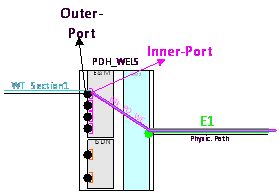Capacity and card ports
Capacity and capacity allocation |
A capacity is additionally allocated to a component type of the category “Card”, which is managed in the capacity allocation. This function defines how the total capacity of the card is allocated on the ports.
Depending on the mode of operation, the transfer rate is defined as capacity, number of channels, or frequency. Standard transfer rates are predefined. If further transfer rates need to be documented, they are to be added to the library.
|
|||||||||||||||||||||||||||||||||
Card ports |
Card ports are generated automatically according to the specifications of the capacity definition and allocation and have the following characteristics:
|
|||||||||||||||||||||||||||||||||
|
|
|||||||||||||||||||||||||||||||||
Mode of operation/Mixed ports |
The mode of operation of the card port is defined by the mode of operation of the card. For cards with mixed operation, the ports of a card can be allocated different operations – mixed ports.
|
|||||||||||||||||||||||||||||||||
Usage control |
In the column „Check“,”Behaviour“can be defined when using a card port with a transport container. The following available options can be selected: |
|||||||||||||||||||||||||||||||||
|
|
|||||||||||||||||||||||||||||||||
Inner/outer ports |
Examples of the use of inner ports for the realisation of a port as an interface are shown in the following.
|
|||||||||||||||||||||||||||||||||
Example 1: PDH – SDH |
Example 1: Transition from PDH via SDH •Inner port: SDH - VC-12 Container (is routed via STM-1) •Outer port: PDH - E1-TC, is automatically routed via VC-12 |
|||||||||||||||||||||||||||||||||
|
|
|||||||||||||||||||||||||||||||||
|
Outer port corresponds to the physical connection side. Inner port corresponds to the internal logical port. |
|||||||||||||||||||||||||||||||||
|
|
|||||||||||||||||||||||||||||||||
|
If the outer port is used with a TC, the latter is directly wired-up in the TC ending on the inner port. The following dependencies must be observed when using the port with transport containers:
|
|||||||||||||||||||||||||||||||||
|
A peculiarity as regards port usage is port usage with a customer connection because in this case, there is no port usage check, i.e. port usage can always be higher than port capacity. |
Example 2: WT – PDH |
Example 1: Transition from WT via SDH •Inner port: PDH – 64 Kbit container (is routed via PDH- E1) •Outer port: WT – 3.4 kHz Section TC, is automatically routed via 64 Kbit
|
|
|
Application |
When using an inner/outer port with a transport container whose capacity is equivalent to the port capacity, the system asks which port is to be allocated (inner or outer port).
|



